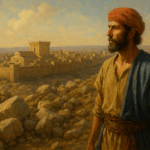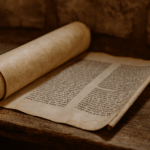Home | Bible Resources | Historical Books
Nehemiah: Faith That Builds: Reclaiming Worship, Rebuilding Walls, and Renewing Covenant Loyalty
Introduction
Nehemiah is the story of a man who left comfort for calling, who wept over the broken walls of Jerusalem and risked everything to restore God’s reputation among His people. Set nearly a century after the Babylonian exile began, Nehemiah continues the restoration narrative begun in Ezra. But this time, it’s not just about the temple — it’s about rebuilding the city, restoring dignity, and renewing covenant faithfulness. With prayers and perseverance, Nehemiah leads the remnant to rebuild physical walls — but more importantly, to rebuild spiritual walls around a people prone to compromise. The book reminds us that revival is not merely emotional—it’s built on confession, covenant, and courageous leadership under God’s hand.
1. Title, Author, and Date
The book of Nehemiah records the memoirs and reforms of Nehemiah, a godly leader and cupbearer to the Persian king Artaxerxes. It continues the restoration narrative of post-exilic Israel.
Title Meaning: “Nehemiah” (נְחֶמְיָה) means “Yahweh comforts.” In Greek: Nehemias (Νεεμιας).
Authorship: Traditionally attributed to Nehemiah, with final compilation likely by Ezra or a post-exilic scribe. Nehemiah writes in first-person (cf. Neh 1:1; 7:5).
Date: Events span roughly 445–432 BC. Nehemiah’s return occurs in the 20th year of Artaxerxes I (Neh 2:1).
Historical Setting: Takes place during the Persian Empire’s dominance, following the decree of Cyrus (538 BC) and the earlier return led by Zerubbabel and Ezra.
Covenantal Role: Continues the reestablishment of post-exilic Israel under the Abrahamic and Mosaic Covenants, preparing for the coming of Messiah.
Redemptive-Historical Flow: Restoration — part of the Redemption to Restoration arc, moving from exile to hopeful reformation.
Book Stats:
Chapters: 13
Verses: 406
Approx. Word Count (LSB): 10,500
2. Purpose and Themes
Nehemiah’s primary purpose is to document the rebuilding of Jerusalem’s walls and the spiritual reformation of the remnant. It reveals how faith-fueled leadership, rooted in prayer and Scripture, can restore both cities and souls.
Theological Purpose: To show how God uses faithful, praying leaders to restore His people for covenantal obedience and public witness.
Major Doctrines:
- Sovereignty of God in political and spiritual renewal
- Covenant faithfulness and repentance
- Spiritual leadership and opposition
- The Word of God as the foundation of reformation
Key Literary Features:
- First-person memoir style (Neh 1–7, 13)
- Lists, prayers, and public readings (e.g., Neh 3; 8)
- Parallel structure with Ezra (return → restoration → reform)
3. Outline
Nehemiah unfolds in two primary movements: rebuilding Jerusalem’s physical walls (chs. 1–7) and reforming Israel’s spiritual walls (chs. 8–13).
I. Nehemiah’s Calling and Mission (1:1–2:20)
A. Nehemiah’s burden and prayer (1:1–11)
B. Commission from Artaxerxes (2:1–8)
C. Arrival and inspection of Jerusalem (2:9–20)
II. Rebuilding the Walls Despite Opposition (3:1–7:73a)
A. Organization of builders and sectioned assignments (3:1–32)
B. External threats and spiritual resilience (4:1–23)
C. Internal injustice and Nehemiah’s reforms (5:1–19)
D. Conspiracy and opposition escalate (6:1–14)
E. Completion of the wall and recognition of God’s help (6:15–7:4)
F. Census and returnees reaffirm identity (7:5–73a)
III. Renewal Through the Word and Covenant (7:73b–10:39)
A. Public reading of the Law (8:1–12)
B. Feast of Booths restoration (8:13–18)
C. National confession and praise (9:1–38)
D. Covenant renewal and commitments (10:1–39)
IV. Reestablishing the City and Its Worship (11:1–13:3)
A. Repopulating Jerusalem and cities (11:1–36)
B. Priestly and Levitical orders restored (12:1–26)
C. Dedication of the rebuilt wall (12:27–47)
D. Nehemiah’s final reforms (13:1–31)
Canonical Flow: Nehemiah concludes the Old Testament historical narrative (Genesis–Nehemiah), bridging the gap toward the silence before Christ’s first advent.
4. Key Themes and Theological Contributions
Nehemiah intertwines leadership, worship, and the Word of God as means of spiritual renewal, emphasizing God’s covenantal faithfulness in the face of persistent human frailty.
- Creation → Restoration: Nehemiah depicts a microcosm of new creation within the ruins of Jerusalem—chaos brought to order through faithful obedience.
- Covenantal Renewal: The Mosaic Covenant is reaffirmed through confession and covenant recommitment (Neh 9–10).
- Scripture-Centered Reform: The public reading and exposition of the Law (Neh 8) establishes Scripture as the foundation for revival.
- Leadership and Providence: Nehemiah’s strategic prayer life, moral courage, and wise governance highlight how godly leadership cooperates with divine providence.
📌 Memory Verse: Nehemiah 8:10b (LSB) — “Do not be grieved, for the joy of Yahweh is your refuge.”
⚔️ Major Rebellions/Turning Points:
- Opposition to the Wall: Sanballat and Tobiah led external resistance, revealing the enemy’s disdain for God’s restoration plan (Neh 4–6).
- Internal Exploitation: Nehemiah confronts Jewish nobles who were enslaving their own kin, showing how covenant compromise begins within (Neh 5).
- Neglect of Covenant Commitments: Despite renewal, Nehemiah returns to find Sabbath-breaking, intermarriage, and temple defilement—requiring bold reforms (Neh 13).
5. Christ in Nehemiah
Though Christ is not mentioned directly, Nehemiah points forward to the True Rebuilder—Jesus—who restores not just walls, but hearts, bringing final redemption to God’s covenant people.
Typological Foreshadowing:
- Nehemiah as a type of Christ: intercessor (1:4–11), restorer, and purifier (13:30–31)
- Wall dedication mirrors Christ’s triumphal entry — a public declaration of God’s kingdom power (Neh 12)
Christological Themes:
- Jesus is the ultimate Rebuilder of spiritual ruins (Isa 61:4; Luke 4:18–19)
- Fulfillment of the covenant promised in the Law proclaimed in Nehemiah 8–10 (Matt 5:17; Heb 8)
Cross-Reference Chart (Recommended Visual Aid)
| Nehemiah Event | Fulfilled in Christ |
|---|---|
| Wall Rebuilt to Protect | Christ builds the Church (Matt 16:18) |
| Law Read Publicly | Christ fulfills the Law (Matt 5:17) |
| Covenant Reaffirmed | New Covenant sealed in Christ (Luke 22:20) |
| Temple Purification (Neh 13) | Jesus cleanses the Temple (John 2:13–17) |
6. Historical and Literary Notes
Nehemiah blends historical memoir, civil records, and theological narrative, offering one of the most personal glimpses into post-exilic leadership and faithfulness under pressure.
Historical Parallels:
- Persian influence: Nehemiah’s role under Artaxerxes I aligns with known Persian court customs.
- Use of letters, decrees, and inscriptions reflects authentic Achaemenid administration.
Genre Observations:
- Historical narrative with autobiographical tone
- Includes prayers, genealogies, and legal reforms
Theological Contribution:
- Reinforces the post-exilic hope of restoration
- Emphasizes the centrality of Scripture, prayer, and covenant obedience
👤 Key Characters:
- Nehemiah – Cupbearer turned governor; visionary leader and prayerful reformer
- Ezra – Scribe and priest; leads public reading of the Law (Neh 8)
- Sanballat – Samaritan official; hostile antagonist to the restoration
- Tobiah – Ammonite conspirator; spiritual saboteur within the temple
- Artaxerxes I – Persian king who grants Nehemiah’s commission
- Levites & Priests – Vital to the covenantal renewal and worship restoration
7. Applications for Today
Nehemiah offers enduring lessons for leaders, churches, and believers seeking to rebuild what sin has torn down — through prayer, Scripture, and unwavering loyalty to God.
Discipleship Formation
- Revival begins with private prayer and results in public action
- Faithful obedience often requires confronting sin within the covenant community
Worldview and Ethics
- Culture will oppose rebuilding what God wants restored (cf. opposition narrative)
- Covenant obedience includes economic justice, Sabbath observance, and family holiness
Leadership and Mission
- God raises leaders like Nehemiah who combine spiritual depth with administrative wisdom
- The mission of restoration includes protecting worship and guarding against compromise
8. Shoe Leather Discipleship Tie-In
This book shows us that revival is not just emotional — it is built on truth, led by prayer, and sustained by courageous obedience.
Nehemiah challenges us to weep over spiritual ruins, pray for God’s hand, and rise to rebuild what’s broken in our generation. His life models the daily walk of covenant faithfulness — one where bold reforms begin with humble prayers. In a world full of opposition, distraction, and compromise, Nehemiah reminds us that walking with God means standing for truth, leading with integrity, and rejoicing in the joy of the Lord — our strength and refuge.











